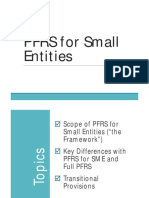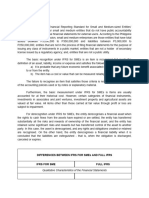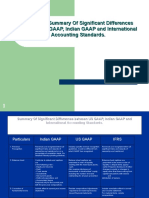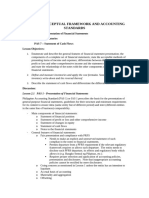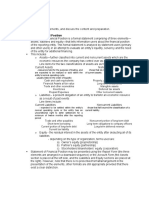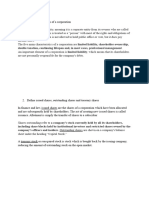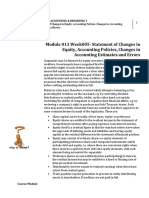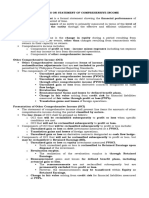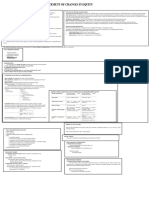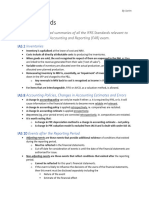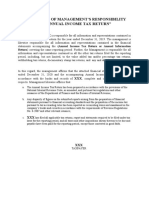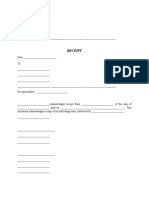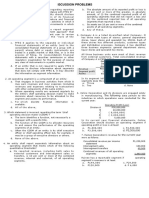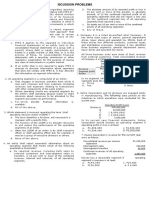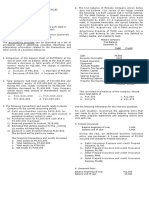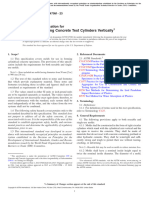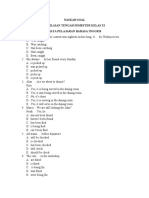0 ratings0% found this document useful (0 votes)
72 viewsPublic Utility Entity Is Not Allowed To Use The Pfrs For Smes in The Philippines)
Public Utility Entity Is Not Allowed To Use The Pfrs For Smes in The Philippines)
Uploaded by
Glen JavellanaThis document summarizes the key requirements for financial statement presentation according to the PFRS for SMEs. It outlines that financial statements should include a statement of financial position, statement of comprehensive income (either single or separate income statement and other comprehensive income statement), statement of changes in equity, statement of cash flows, and accompanying notes. It provides details on the minimum line items required for each financial statement and acceptable presentation methods. The overall purpose is to establish guidelines for SMEs to prepare financial statements that provide useful information to users through a cost-effective process.
Copyright:
© All Rights Reserved
Available Formats
Download as DOCX, PDF, TXT or read online from Scribd
Public Utility Entity Is Not Allowed To Use The Pfrs For Smes in The Philippines)
Public Utility Entity Is Not Allowed To Use The Pfrs For Smes in The Philippines)
Uploaded by
Glen Javellana0 ratings0% found this document useful (0 votes)
72 views6 pagesThis document summarizes the key requirements for financial statement presentation according to the PFRS for SMEs. It outlines that financial statements should include a statement of financial position, statement of comprehensive income (either single or separate income statement and other comprehensive income statement), statement of changes in equity, statement of cash flows, and accompanying notes. It provides details on the minimum line items required for each financial statement and acceptable presentation methods. The overall purpose is to establish guidelines for SMEs to prepare financial statements that provide useful information to users through a cost-effective process.
Original Title
SMEs
Copyright
© © All Rights Reserved
Available Formats
DOCX, PDF, TXT or read online from Scribd
Share this document
Did you find this document useful?
Is this content inappropriate?
This document summarizes the key requirements for financial statement presentation according to the PFRS for SMEs. It outlines that financial statements should include a statement of financial position, statement of comprehensive income (either single or separate income statement and other comprehensive income statement), statement of changes in equity, statement of cash flows, and accompanying notes. It provides details on the minimum line items required for each financial statement and acceptable presentation methods. The overall purpose is to establish guidelines for SMEs to prepare financial statements that provide useful information to users through a cost-effective process.
Copyright:
© All Rights Reserved
Available Formats
Download as DOCX, PDF, TXT or read online from Scribd
Download as docx, pdf, or txt
0 ratings0% found this document useful (0 votes)
72 views6 pagesPublic Utility Entity Is Not Allowed To Use The Pfrs For Smes in The Philippines)
Public Utility Entity Is Not Allowed To Use The Pfrs For Smes in The Philippines)
Uploaded by
Glen JavellanaThis document summarizes the key requirements for financial statement presentation according to the PFRS for SMEs. It outlines that financial statements should include a statement of financial position, statement of comprehensive income (either single or separate income statement and other comprehensive income statement), statement of changes in equity, statement of cash flows, and accompanying notes. It provides details on the minimum line items required for each financial statement and acceptable presentation methods. The overall purpose is to establish guidelines for SMEs to prepare financial statements that provide useful information to users through a cost-effective process.
Copyright:
© All Rights Reserved
Available Formats
Download as DOCX, PDF, TXT or read online from Scribd
Download as docx, pdf, or txt
You are on page 1of 6
Does include true and fair override but
PFRS for SMEs this should be extremely rare
PFRS for SMEs presumes the reporting
Section 1 – Small and Medium-sized entity is a going concern
Entities SMEs shall present a complete set of
The standard does not contained a limit financial statements at least annually
on the size of an entity that may use the At least one year comparative prior
PFRS for SMEs provided that it does not period financial statements and note data
have public accountability (take note Presentation and classification of items
that in the Philippines, the SEC prescribes should be consistent from one period to
PFRS for SMEs for certain Corporations) the next
Nor is there a restriction on its use by a
public utility, not-for-profit entity, or
public sector entity (take note that a
public utility entity is not allowed to use
the PFRS for SMEs in the Philippines) Must justify and disclose any change in
A subsidiary whose parent or group uses presentation or classification of items in
full PFRSs may use the PFRS for SMEs if financial statements
the subsidiary itself does not have public Materiality: an omission or misstatement is
accountability material if it could influence economic.
The standard does not require any Complete set of financial statements:
special approval by the owners of an SME o Statement of financial position
for it to be eligible to use the PFRS for o Either a single statement of
SME comprehensive income, or two
Listed companies, no matter how small, statements: an income statement and a
may not use the PFRS for SMEs statement of comprehensive income
o Statement of changes in equity
Section 2 – Concepts and Pervasive o Statement of cash flows
Principles o Notes
Objective of SMEs’ Financial statements: If the only changes to equity arise from profit
to provide information about Financial or loss, payment of dividends, correction of
position, performance, cash flows errors, and changes in accounting policy, an
Also shows results of stewardship of entity may present a single (combine)
management over resources statement of the separate statements of
Qualitative characteristics comprehensive income and of changes in
(understandability, relevance, materiality, equity (see Section 6)
reliability, substance over form, An entity may present only an income
prudence, completeness, comparability, statement (no statement of comprehensive
timeliness, balance between benefit and income) if it has no items of other
cost) comprehensive income (OCI)
Basic recognition concept- an item that The only OCI items under the PFRS for SMEs
meets the definition of an Asset, Liability, are:
Income, or Expense is recognized in the o Some foreign exchange gains and losses
financial statements if: relating to a net investment in a foreign
o It is probable that future benefits operation (see Section 30)
associated with the item will flow to o Some changes in fair values of hedging
or from the entity, and instruments – in a hedge of variable
o The item has cost or value that can interest rate risk of a recognized financial
be measured reliably instrument, foreign exchange risk or
Basic measurement concepts commodity price risk in a firm commitment
o Historical cost and fair value are or highly probable forecast transaction, or
described a net investment in a foreign operation
o Basic financial assets and liabilities (see Section 12)
are generally measured at amortized o Some actuarial gains and losses (see
cost Section 28)
o Other financial assets and liabilities
are generally measured at fair value Section 4 – Statement of Financial
through profit or loss Position
o Non-financial assets are generally May still be include ‘Balance Sheet’
measure using a cost-based measure Current/Non-Current split is not required if the
o Non-financial liabilities are generally entity concludes that a liquidity approach
measured at settlement amount produces more relevant information
Concepts of profit or loss and total Some minimum line items required. These
comprehensive income include:
Offsetting of assets and liabilities or of o Cash and equivalents
income and expenses is prohibited unless o Receivables
expressly required or permitted o Financial assets
o Inventories
Section 3 – Financial Statement o Property, Plant, and Equipment
Presentation o Investment property at fair Value
Fair presentation: presumed to result of o Intangible Assets
the PFRS for SMEs is followed
o Biological Assets at cost
State compliance with PFRS for SMEs only
o Biological Assets at fair Value
if the financial statements comply in full
o Investment in Associates
o Investment in joint Venture
o Payables -bottom line is profit or loss (as
o Financial Liabilities above)
o Current tax Assets and Liabilities o Statement of Comprehensive
o Deferred tax assets and liabilities income:
o Provisions -Begins with profit or loss
o Non-controlling Interest -Shows each item of other
o Equity of owners of parent comprehensive income
And some required items may be presented in -Bottom line is Total
the statement or in the notes Comprehensive income
o Categories of Property, plant and
Section 6 – statement of Changes in
equipment
Equity and Statement of
o Info about assets with binding sale
Comprehensive Income and Retained
agreements
Earnings
o Categories of receivable
Shows all changes to equity including
o Categories of Inventories
o Total comprehensive income
o Categories of payables
o Owners’ investment
o Employee benefit obligations
o Dividends
o Classes of equity, including OCI and
o Owners’ withdrawal of capita
reserves
o Treasury share transactions
o Details about share capital
Can omit the statement of changes in
Sequencing, format, and titles are not
equity if the entity has no owner
mandated
investments or withdrawals other than
dividends and elects to present a
combined statement of comprehensive
income and retained earnings
Section 7 – Statement of Cash Flows
Section 5- Statement of Comprehensive
Presents information about an entity’s
Income and Income Statement
changes in cash and cash equivalents for
One-statement or two-statement
a period
approach – either a single statement of
comprehensive income, or two Cash flows are classified as operating,
statement: an income statement and a investing, and financing cash flows
statement of comprehensive income Option to use the indirect method or the
direct method to present operating cash
Must segregate discontinued operations
flows
Must present ‘profit or loss’ subtotal if the
entity has any items of other Separate disclosure is required of some
comprehensive income non-cash investing and financing
transactions (for example, acquisition of
Bottom line (‘profit or loss’ in the income
assets by issue of debt)
statement and ‘total comprehensive
Reconciliation of components of cash
income’ in the statement of
comprehensive income) is before
allocating those amounts to non-
controlling interest and owners of the
parent
Section 8 – Notes to the Financial
No item may be labelled ‘extraordinary’
Statements
o But unusual items can be separately
Notes are normally in this sequence:
presented
o Basis of preparation (ie PFRS for SMEs)
o Expenses may be presented by
o Summary of significant accounting policies,
nature (depreciation, purchases of
materials, transport costs, employee including
benefits, etc.) or by function (cost of -information about judgments
sales, distribution costs, -information about key sources of
administrative costs, etc.) either on estimation uncertainty
face of the statement of o Supporting information for items in financial
comprehensive income ( or income statements
statement) or in the notes o Other disclosures
Single statement of comprehensive Comparative prior period amounts are required
income: by Section 3 (unless another section allows
o Revenue omission of prior period amounts)
o Expenses, showing separately:
Section 9 – Consolidated and Separate
- Finance costs
Financial Statements
- Profit or loss from associates
Consolidated financial statement are required
and jointly controlled entities
when a parent company controls another
- Tax expense
entity (a subsidiary).
- Profit or loss (may omit if no
Must consolidate all controlled special-purpose
OCI)
entities(SPEs)
- Items of other comprehensive
Consolidation procedures
income
o Eliminate intracompany transactions and
- Total comprehensive income
balances
(may label profit or loss if no
o Uniform reporting date unless
OCI)
impracticable
Separate statements of income and
o Uniform accounting policies
comprehensive income:
o Income statement:
o Non-controlling interest is presented as o Investment in nonconvertible and non-
part of equity puttable ordinary and preference share
o Losses are allocated to a subsidiary even if o Most commitments to receive loan
non-controlling interest goes negative Initial measurement:
Guidance on separate financial statements (but o Basic financial assets and financial
they are not required). liabilities are initially measure at the
o In a parent’s separate financial transaction price (including transaction
statements, it may account for costs except in the initial
subsidiaries, associates, and joint ventures measurement of financial assets and
that are not held for sale at cost or fair liabilities that are measured at fair
value through profit or loss. value through profit or loss) unless the
Guidance on combined financial statements arrangements constitutes, in effect, a
(but they are not required). financing transaction. A financing
If investor loses control but continues to hold transaction may be indicated in
some investment: relation to the sale of goods or
o If the subsidiary becomes associate, services, for example, if payment is
follow section 14 deferred beyond normal business
o If the subsidiary becomes a jointly terms or is financed at a rate of
controlled, follow section 15 interest that is not a market rate. If the
o If investment does not qualify as an arrangement constitute a financing
associate or jointly controlled entity, treat transaction, measure the financial
it as financial asset under section 11 and asset or financial liability at the
12 present value of the future payments
discounted at a market rate of interest
SECTION 10 – ACCOUNTING POLICIES, for a similar debt instrument.
ESTIMATES AND ERRORS Measurement subsequent to initial
If the PFRS for SMEs addresses an issue, the recognition:
entity must follow the PFRS for SMEs o Debt instruments at amortized cost
If the PFRS for SMEs does not address an issue: using the effective interest method
o Choose policy that results in the most o Debt instruments that are classified as
relevant and reliable information current assets or current liabilities are
o Try to analogise from standards in the measured at the undiscounted amount
PFRS for SMEs of the cash or other consideration
o Or use the concept and pervasive expected to be paid or received (ie net
principles in section 2 of impairment) unless the arrangement
o Entity may look to guidance in full PFRSs constitute a financing transaction. If
the arrangement constitute a financing
(nut not required)
transaction, the entity shall measure
Change in accounting policy:
the debt instrument at the present
o If mandated, follow the transition
value of the future payments
guidance as mandated discounted at a market rate of interest
o If voluntary, retrospective for a similar debt instrument.
Change in accounting estimate: PROSPECTIVE o Investment in non-convertible
Correction of prior period error: RESTATE preference shares and non-puttable
PRIOR PERIODS IF PRACTICABLE ordinary or preference shares:
- if the shares are publicly traded or
SECTION 11 – BASIC FINANCIAL their fair value can otherwise be
NSTRUMENTS measured reliably, measure at fair
PFRS for SMEs has two sections on financial value with changes in fair value
instruments: recognized in profit or loss
o Sec. 11 on BASIC FINANCIAL - measure all other such investments
INSTRUMENTS at cost less impairment
o Sec. 12 on OTHER FI TRANSACTIONS must test all amortized cost instruments
Option to follow PAS 39 instead of sec. 11 and for impairment or uncollectibility
12 previously recognized impairment is
Even if PAS 39 is followed, make sec. 11 and 12 reversed if an event occurring after the
disclosure (not PFRS 7 disclosure) impairment was first recognized causes
Essentially, sec 11 is an amortized historical the original impairment loss to decrease
cost model Guidance is provided on determining fair
values of financial instruments
o The most reliable is quoted price in an
active market
o When a quoted price is not available
o Except for equity investment with the most recent transaction price
quoted price or readily determinable provides evidence of fair value
fair value. These are measured at fair o If there is no active market or recent
value through profit or loss. market transactions, a valuation
Scope of section 11 includes: technique may be used
o Cash Guidance is provided on the effective
o Demand and fixed deposit interest method
o Commercial paper bills
o Accounts and notes receivable and
payable
o Debt instruments where returns to the
holder are fixed or referenced to an Derecognize a financial asset when:
observable rate
o The contractual rights to the cash flows Inventory cost excludes abnormal waste
from the financial asset expire or are and storage, administrative, and selling
settled; costs
o The entity transfer to another party all of If a production process creates joint products
the significant risks and rewards relating to and /or by-products, the costs are allocated on
the financial asset; or a consistent and rational basis
o The entity, despite having retained some A manufacturer allocates fixed production
significant risk and rewards relating to the overheads to inventories based on normal
financial asset, has transferred the ability to capacity
sell the asset on its entirety to an unrelated
third party who is able to exercise that
ability unilaterally and without needing to
impose additional restrictions on the
transfer. Standard costing, retail method, and
Derecognize a financial liability when the most recent purchase price may be used
obligation is discharged, cancelled, or expires only if the result approximates actual
Disclosures: cost
o Categories of financial instruments Impairment – write down to net realizable
o Details of debt and other instruments value (selling price less costs to complete
o Details of derecognitions and sell- see section 27)
o Collateral
o Defaults and breaches on loans payable SECTION 14 – INVESTMENT IN
o Items of income and expense ASSOCIATES
Option to use:
SECTION 12 – ADDITIONAL FINANCIAL o Cost-impairment model (except if
NSTRUMENTS ISSUES there is a published quotation – then
Financial instruments not covered by section must use fair value through profit or
11 (and, therefore, are within section 12) are loss)
measured at fair value through profit or loss. o Equity method (investor recognizes
This includes: its share of profit or loss of the
o Investment in convertible and puttable associate - detailed guidance is
ordinary and preference shares provided)
o Options, forwards, swaps and other o Fair value through profit or loss
derivatives Investment in associates are always
o Financial assets that would otherwise be in classified as non-current assets
section 11 but that have ‘exotic’ provisions
that could cause gain/loss to the holder or SECTION 15 – INVESTMENT IN JOINT
issuer VENTURE
Hedge accounting involves matching the gains For investment in jointly controlled
and losses on a hedging instruments and entities, there is an option for the venture
hedged item. to use:
o It is allowed only for the following kinds of o Cost model (except if there is a
risk: published quotation – then must use
- Interest rate risk of a debt instrument fair value through profit or loss)
measured at amortized cost o Equity method (using the guidance
- Foreign exchange or interest rate risk in sin section 14)
a firm commitment or a highly probable o Fair value through profit or loss
forecast transaction Proportionate consolidation is published
- Price risk of a commodity that it holds For jointly controlled operations, the
or in a firm commitment or highly venturer should recognize assets that it
probable forecast transaction to controls and liabilities it incurs as well as
purchase or sell a commodity its share of income earned and expenses
- Foreign exchange risk in a net that are incurred
investment in a foreign operation For jointly controlled assets, the venturer
o Section 12 defines the type of hedging should recognize its share of the assets
instrument required for hedge accounting and liabilities it incurs as well as income
o Hedges must be documented up front to it earns and expenses that are incurred
qualify for hedge accounting
o Section 12 provides guidance for ISECTION 16 – INVESTMENT
measuring assessing effectiveness PROPERTY
o Special disclosure are required Investment property is investment in
land, buildings (or part of a building), and
SECTION 13 – INVENTORIES some property interests in finance leases
Measured at the lower cost and estimated held to earn rentals or for capital
selling price less costs to complete and sell appreciation or both
Cost is determined using: Property interest that are held under an
o Specific identification is required for large operating lease may be classified as an
items investment property provided the
o Option to choose FIFO or weighted average property would otherwise have met the
definition of an investment property
for others
o LIFO is not permitted Mixed use property must be separated
between investment and operating
Inventory cost includes costs to purchase, costs
property
of conversion, and costs to bring the asset to
If fair value can be measured reliably
present location and condition
without undue cost or effort, use the fair
value through profit or loss model.
Otherwise, an entity must treat o An acquirer must always be identified
investment property as property, plant o The cost of the business combination is
and equipment using section 17 measured. Cost is the fair value of assets
given, liabilities incurred or assumed, and
SECTION 17 – PROPERTY, PLANT AND equity instruments issued, plus costs
EQUIPMENT directly attributable to the combination
Historical cost-depreciation-impairment o At the acquisition date, the cost is
model only allocated to the assets acquired and
The revaluation model (as in IAS 16 ) is liabilities and provisions for contingent
not permitted liabilities assumed. The identifiable assets
Section 17 applies to most investment acquired and liabilities and provisions for
property as well (but if fair value of contingent liabilities assumed are
investment property can be measured measured at their fair values. Any
reliably without undue cost or effort then difference between cost and amounts
the fair value model in section 16 applies) allocated to identifiable assets and
Section 17 applies to property held for liabilities (including provisions) is
sale – there is no special section on recognized as goodwill or so called
assets held for sale. For sale is an ‘negative goodwill’.
indicator of possible impairment All goodwill must be amortized. If the entity is
Measurement is initially at cost, including unable to estimate useful life, then use 10
costs to get the property ready for its years.
intended use subsequent to acquisition, ‘Negative goodwill’ – first reassess original
the entity uses the cost-depreciation- accounting. If that is ok, then immediate credit
impairment model, which recognizes to profit or loss
depreciation and impairment of the Impairment testing of goodwill –follow section
carrying amount 27
Reversal of goodwill impairment is not
permitted
The carrying amount of an asset, less
estimated residual value, is depreciated over SECTION 20 – LEASES
the assets anticipated useful life. The method Scope includes arrangements that contain a
of depreciation shall be the method that best lease (IFRIC 4)
reflects the consumption of the assets benefits Leases are classified as either finance leases or
over its life. Separate significant components operating leases.
should be depreciated separately o Finance leases result in substantially all
Components depreciation only if major parts of the risks and rewards incidental to
an item of PPE have significantly different ownership being transferred between the
patterns of consumption of economic benefits parties, while operating leases do not.
Review useful life, residual value, depreciation o Substantially all risks and rewards of
rate only if there is a significant change in the ownership are presumed transferred if:
asset or how it is used. Any adjustment is a - The lease transfer ownership of the
change in estimate (prospective) asset to the lessee by the end of the
Impairment testing and reversal –follow section lease term
27 - The lessee has a ‘bargain purchase
option’
SECTION 18 – INTANGIBLE ASSETS OTHER
THAN GOODWILL
No recognition of internally generated
intangible assets. Therefore: - the lease term is for the major part of
o Charge all research and development cost the economic life of the asset even if
to expense title is not transferred
o Charge the following items to expense - at the inception of the lease the present
when incurred: costs of internally value of the minimum lease payments
generated brands, logos and masthead, amounts to at least substantially all of
start-up costs, training costs, advertising, the fair value of the leased asset
and relocating of a division or entity - the leased assets are of such a
Amortization model for intangibles that are specialized nature that only the lessee
purchased separately, acquired in a business can use them without major
combination, acquired by grant, and acquired modifications
by exchange of other assets - the lessee bears the lessor losses if
Amortize over useful life. If the entity is unable cancelled
to estimate useful life, then use 10 years. - a secondary rental period at below
Review useful life, residual value, depreciation market rates
rate only if there is a significant change in the - The residual value risk is borne by the
asset or how it is used. Any adjustment if a lessee.
change in estimate (prospective) Lessees - finance lease:
Impairment testing – follow section 27 o The rights and obligations are to be
Any revaluation of intangible assets is recognized as assets and liabilities at
prohibited fair value, or, if lower, the present
value of the minimum lease payments.
SECTION 19 – BUSINESS COMBINATIONS Any direct costs of the lessee are
AND GOODWILL added to the asset amount recognized.
Section does not apply to combinations of Subsequently, payments are to be split
entities under common control between a finance charge and
Acquisition (purchase) method. Under this reduction of the liability. The asset
method:
should be depreciated either over the o Lessors retain the assets on their balance
useful life or the lease term sheet and payments are to be recognized as
Lessees – operating leases: income on the straight line basis, unless
o Payments are to be recognized as an payments are structured to increase in line
expense on the straight line basis, with expected general inflation or another
unless payments are structured to systematic basis is better representative of
increase in line with expected general the tine pattern of the user’s benefit
inflation or another systematic basis is Sale and leaseback:
better representative of the time o If a sale and leaseback results in a finance
pattern of the user’s benefit lease, the seller should not recognize any
Lessors- finance leases: excess as a profit, but recognize the
o The rights are to be recognized as excess over the lease term
assets held, i.e. as a receivable at an o If a sale and leaseback results in an
amount equal to the net investment in operating lease, and the transaction was
the lease. The net investment in a at fair value, the seller shall recognize any
lease is the lessor’s gross investment profits immediately.
in the lease (including unguaranteed
residual value) discounted at the SECTION 21 – PROVISIONS AND
interest rate implicit in the lease CONTINGENCIES
o For finance leases other than those
involving manufacturer or dealer
lessors, initial direct costs are included
in the initial measurement of the
finance lease receivable and reduce
the amount of income recognized over
the lease term.
o If there is an indication that the
estimated unguaranteed residual value
used in computing the lessors gross
investment in the lease has change
significantly, the income allocation
over the lease term is revised, and any
reduction in respect of amounts
accrued is recognized immediately in
profit or loss.
Lessors – finance leases by a
manufacturer or dealer:
o a finance lease of an asset by a
manufacturer or dealer lessor gives
rise to two types of income:
- profit or loss equivalent to the
profit or loss resulting from an
outright sale of the asset being
leased, at normal selling prices,
reflecting any applicable volume or
trade discounts; and
- Finance income over the lease
term.
o The sales revenue recognized at the
commencement of the lease term by a
manufacturer or dealer lessor is the
fair value of the asset or, if lower, the
present value of the minimum lease
payments accruing to the lessor,
computed at a market rate of interest.
o The cost of sale recognized at the
commencement of the lease term is
the cost, or carrying amount if
different, of the leased property less
the present value of the unguaranteed
residual value. The difference between
the sales revenue and the cost of sale
is the selling profit, which is recognized
in accordance with the entity’s policy
for outright sales
o If artificially low rates of interest are quoted,
selling profit shall be restricted to that
which would apply if a market rate of
interest were charged. Costs incurred by
manufacturer or dealer lessors in
connection with negotiating and arranging a
lease shall be recognized as an expense
when the selling profit is recognized.
Lessors – operating leases:
You might also like
- Diff Between Sme & Small Entities PDFDocument49 pagesDiff Between Sme & Small Entities PDFJerico CelesteNo ratings yet
- Chart of Accounts List: AssetsDocument18 pagesChart of Accounts List: AssetsGlen JavellanaNo ratings yet
- Pfrs RepDocument9 pagesPfrs RepAngel Nhova Pepito OmalayNo ratings yet
- Module 1B - PFRS For Medium Entities NotesDocument25 pagesModule 1B - PFRS For Medium Entities NotesLee SuarezNo ratings yet
- IFRS For SMEsDocument8 pagesIFRS For SMEssharonshiko292No ratings yet
- Webinar PPT SMEspptxDocument34 pagesWebinar PPT SMEspptxChristine Joyce MagoteNo ratings yet
- Full Pfrs Pfrs For Sme Pfrs For Small Entities Comparison CompressDocument28 pagesFull Pfrs Pfrs For Sme Pfrs For Small Entities Comparison Compressmacatherinetumanlao83No ratings yet
- Other Reporting FrameworksDocument12 pagesOther Reporting FrameworksPaula De RuedaNo ratings yet
- Afm 1Document20 pagesAfm 1antrikshaagrawalNo ratings yet
- Lesson 2.1 & 2.2Document9 pagesLesson 2.1 & 2.2shadowlord468No ratings yet
- Accntg4 Ifrs Sme 4Document11 pagesAccntg4 Ifrs Sme 4Shariine BestreNo ratings yet
- Full Pfrs Pfrs For Sme Pfrs For Small Entities ComparisonDocument33 pagesFull Pfrs Pfrs For Sme Pfrs For Small Entities ComparisonJOY YangcoNo ratings yet
- Simplified Summary of Significant Differences Between US GAAP, Indian GAAP and International Accounting StandardsDocument7 pagesSimplified Summary of Significant Differences Between US GAAP, Indian GAAP and International Accounting Standardsjoy26iNo ratings yet
- Pfrs For SmesDocument12 pagesPfrs For SmeskristelNo ratings yet
- Summary IFRS For SMEDocument17 pagesSummary IFRS For SMEAbi Serrano Taguiam100% (1)
- LESSON2PRELIMDocument8 pagesLESSON2PRELIMTrisha VelascoNo ratings yet
- Shareholder Value & Global Reporting. Reconciliation of Indian GAAP Financial Statements With US/International GAAPSDocument15 pagesShareholder Value & Global Reporting. Reconciliation of Indian GAAP Financial Statements With US/International GAAPSvdforeNo ratings yet
- National Exchange Actors Association (NEAA) : Difference Between IFRS & US GAAPDocument10 pagesNational Exchange Actors Association (NEAA) : Difference Between IFRS & US GAAPEshetieNo ratings yet
- PFRS PresentationDocument19 pagesPFRS PresentationHanna Shiloh MontalanNo ratings yet
- Notes To PASDocument37 pagesNotes To PASJenilyn CalaraNo ratings yet
- Diff Bet USGAAP IGAAP IFRSDocument7 pagesDiff Bet USGAAP IGAAP IFRSrajdeeppawarNo ratings yet
- Final SummaryDocument6 pagesFinal SummaryAkanksha singhNo ratings yet
- FINANCIAL-REPORTINGDocument21 pagesFINANCIAL-REPORTINGAmir Jaheer Guinomla SapalNo ratings yet
- Kaplan - SBR Simplest SummaryDocument13 pagesKaplan - SBR Simplest Summarymuazzam.danganaNo ratings yet
- Lesson2 1Document6 pagesLesson2 1Ira Charisse BurlaosNo ratings yet
- 4ac3 - Advanced Financial Acctg. Chapter 2: Investments in Equity SecuritiesDocument10 pages4ac3 - Advanced Financial Acctg. Chapter 2: Investments in Equity SecuritiesAuzair AnwarNo ratings yet
- Financial Accounting 2 SummaryDocument10 pagesFinancial Accounting 2 SummaryChoong Xin WeiNo ratings yet
- Diff Bet USGAAP IGAAP IFRSDocument7 pagesDiff Bet USGAAP IGAAP IFRSfenildivyaNo ratings yet
- Statement of Financial Position: Zena Bituin F. Gardoce BSA 2101Document3 pagesStatement of Financial Position: Zena Bituin F. Gardoce BSA 2101Christine Marie RamirezNo ratings yet
- NotesDocument2 pagesNotesNoella Marie BaronNo ratings yet
- SMALL AND MEDIUM EntitiesDocument19 pagesSMALL AND MEDIUM Entitiesmarx marolinaNo ratings yet
- 07 Handout 1.1Document6 pages07 Handout 1.1jeyahNo ratings yet
- Acc201 Su5Document13 pagesAcc201 Su5Gwyneth LimNo ratings yet
- Conceptual Framework and Theoretical Structure of Financial Accounting and Reporting, Part IIDocument16 pagesConceptual Framework and Theoretical Structure of Financial Accounting and Reporting, Part IIJi BaltazarNo ratings yet
- Chapter 14 Financial StatementsDocument82 pagesChapter 14 Financial StatementsKate CuencaNo ratings yet
- Philippine School of Business Administration: Integrated Review - Auditing BLD 2 Semester 2020-2021Document13 pagesPhilippine School of Business Administration: Integrated Review - Auditing BLD 2 Semester 2020-2021Thalia UyNo ratings yet
- SMEsDocument8 pagesSMEsThe Second OneNo ratings yet
- CHAPTER 26 Statement of Comprehensive Income (Concept Map)Document1 pageCHAPTER 26 Statement of Comprehensive Income (Concept Map)kateyy99100% (1)
- Pfrs For Smes - Acpapp WebsiteDocument56 pagesPfrs For Smes - Acpapp WebsiteThessaloe B. Fernandez100% (2)
- Ifrs For SMEsDocument104 pagesIfrs For SMEsApril AcboNo ratings yet
- NotesDocument3 pagesNotesMichaela Marie MierNo ratings yet
- FS Reviewer CH1Document10 pagesFS Reviewer CH1karen perrerasNo ratings yet
- Module 013 Week005-Statement of Changes in Equity, Accounting Policies, Changes in Accounting Estimates and ErrorsDocument7 pagesModule 013 Week005-Statement of Changes in Equity, Accounting Policies, Changes in Accounting Estimates and Errorsman ibeNo ratings yet
- B.1 Conceptual FrameworkDocument4 pagesB.1 Conceptual FrameworkNina SongcoNo ratings yet
- IA3 Statement of Financial PositionDocument36 pagesIA3 Statement of Financial PositionHello HiNo ratings yet
- FAR BULLET NOTES 5 - Statement of Comprehensive IncomeDocument2 pagesFAR BULLET NOTES 5 - Statement of Comprehensive IncomeDemon AlphaNo ratings yet
- Accounting Standards (Group-Ii) : AS - 4: Contingencies and Events Occurring After The Balance Sheet DateDocument14 pagesAccounting Standards (Group-Ii) : AS - 4: Contingencies and Events Occurring After The Balance Sheet DateNitin pandeyNo ratings yet
- Disclosures Under IFRS 9: What's The Aim?Document16 pagesDisclosures Under IFRS 9: What's The Aim?Ishtiaq AzamNo ratings yet
- Lesson 13Document9 pagesLesson 13Jamaica bunielNo ratings yet
- Objective of Financial Statements:: 1. Understandability 2. Relevance 3. MaterialityDocument14 pagesObjective of Financial Statements:: 1. Understandability 2. Relevance 3. Materialityredearth2929No ratings yet
- 1.2 Presentation of Financial StatementsDocument34 pages1.2 Presentation of Financial StatementsmayankpareekcfaNo ratings yet
- PAS-1-GROUP-2 - Revised2Document24 pagesPAS-1-GROUP-2 - Revised2Euro Jules E. DuriguezNo ratings yet
- Group Reporting II: Application of The Acquisition Method Under IFRS 3Document77 pagesGroup Reporting II: Application of The Acquisition Method Under IFRS 3فهد التويجريNo ratings yet
- STATEMENT OF CHANGES IN EQUITYDocument1 pageSTATEMENT OF CHANGES IN EQUITYZKS EditsNo ratings yet
- Crownford General Corp. Notes To Financial Statements: (Amounts in Philippine Pesos)Document19 pagesCrownford General Corp. Notes To Financial Statements: (Amounts in Philippine Pesos)Mel VillahermosaNo ratings yet
- LONGDocument4 pagesLONGKirsten ManiacupNo ratings yet
- FAR IFRS StandardsDocument11 pagesFAR IFRS Standardsyfarhana2002No ratings yet
- NAS For MEs ChecklistDocument4 pagesNAS For MEs Checklistsumankandel015100% (4)
- Internal Control of Fixed Assets: A Controller and Auditor's GuideFrom EverandInternal Control of Fixed Assets: A Controller and Auditor's GuideRating: 4 out of 5 stars4/5 (1)
- Sworn DeclarationDocument1 pageSworn DeclarationGlen Javellana100% (1)
- Books of Accounts - ManualDocument4 pagesBooks of Accounts - ManualGlen JavellanaNo ratings yet
- Statement of Management Responsibility For Annual Income Tax ReturnDocument1 pageStatement of Management Responsibility For Annual Income Tax ReturnGlen JavellanaNo ratings yet
- XXX Notes To Financial StatementsDocument5 pagesXXX Notes To Financial StatementsGlen JavellanaNo ratings yet
- Receipt TemplateDocument1 pageReceipt TemplateGlen JavellanaNo ratings yet
- xxxSTATEMENT OF MANAGEMENT RESPONSIBILITY FOR ANNUAL INCOME TAX RETURNDocument1 pagexxxSTATEMENT OF MANAGEMENT RESPONSIBILITY FOR ANNUAL INCOME TAX RETURNGlen JavellanaNo ratings yet
- Acctg RecommendationDocument1 pageAcctg RecommendationGlen JavellanaNo ratings yet
- Request For Travel & Allowance ExpensesDocument1 pageRequest For Travel & Allowance ExpensesGlen JavellanaNo ratings yet
- Format of Implementing Rules and RegulationsDocument6 pagesFormat of Implementing Rules and RegulationsGlen JavellanaNo ratings yet
- Irr On Employees Credit LineDocument2 pagesIrr On Employees Credit LineGlen JavellanaNo ratings yet
- 211toa PDFDocument3 pages211toa PDFGlen JavellanaNo ratings yet
- SMEs - TOA - VALIX 2018 PDFDocument17 pagesSMEs - TOA - VALIX 2018 PDFHarvey Dienne Quiambao100% (1)
- Topic 26 Internal Control Sales Cycle PDFDocument6 pagesTopic 26 Internal Control Sales Cycle PDFGlen JavellanaNo ratings yet
- Operations Operations Operations Operations Manual Manual Manual ManualDocument2 pagesOperations Operations Operations Operations Manual Manual Manual ManualGlen JavellanaNo ratings yet
- 1365464987statement of Financial Positio 3Document1 page1365464987statement of Financial Positio 3Glen JavellanaNo ratings yet
- 5134649879operating Segment FinalDocument8 pages5134649879operating Segment FinalGlen JavellanaNo ratings yet
- Steps in The Accounting Process (Cycle) : Lecture NotesDocument12 pagesSteps in The Accounting Process (Cycle) : Lecture NotesGlen JavellanaNo ratings yet
- 13213213operating SegmentDocument2 pages13213213operating SegmentGlen JavellanaNo ratings yet
- C. Either A or B.: Discussion ProblemsDocument8 pagesC. Either A or B.: Discussion ProblemsGlen JavellanaNo ratings yet
- 3214649879operating SegmentDocument1 page3214649879operating SegmentGlen JavellanaNo ratings yet
- Steps in The Accounting Process (Cycle) : Lecture NotesDocument2 pagesSteps in The Accounting Process (Cycle) : Lecture NotesGlen JavellanaNo ratings yet
- Raymond Trevor Bradley - The Psychophysiology of Intuition: A Quantum-Holographic Theory of Nonlocal CommunicationDocument38 pagesRaymond Trevor Bradley - The Psychophysiology of Intuition: A Quantum-Holographic Theory of Nonlocal CommunicationDominos021100% (1)
- Kinship, Marriage, and The HouseholdDocument25 pagesKinship, Marriage, and The HouseholdMichelle Taton HoranNo ratings yet
- Veterinary ToxicologyDocument822 pagesVeterinary ToxicologyPau Ibarra RieraNo ratings yet
- Foundation & Blood Module A1 2Document10 pagesFoundation & Blood Module A1 2Junaid Shah100% (1)
- Free Den 2009Document22 pagesFree Den 2009RafaelSerraNo ratings yet
- Business Analysis CheatsheetDocument29 pagesBusiness Analysis CheatsheetdevilscarerNo ratings yet
- Table of Specification First Periodical Test Mathematics Iv S.Y 2018-2019Document9 pagesTable of Specification First Periodical Test Mathematics Iv S.Y 2018-2019HANNA GALE100% (2)
- SM FM UNIT 1 QP AY 2023-2024Document1 pageSM FM UNIT 1 QP AY 2023-2024venkateswarluvelisalNo ratings yet
- JModelicaUsersGuide-1 4 0Document96 pagesJModelicaUsersGuide-1 4 0ilmenaumanNo ratings yet
- Aptitude Test.2021Document34 pagesAptitude Test.2021loraine NomusNo ratings yet
- Invoking Blessings Upon The Prophet From Dalail Al Khayrat Imam Al JazuliDocument18 pagesInvoking Blessings Upon The Prophet From Dalail Al Khayrat Imam Al JazulirathiikaNo ratings yet
- MAT 210: Brief Calculus: Any Such Changes Will Be Announced in Class and Updated in The Online SyllabusDocument6 pagesMAT 210: Brief Calculus: Any Such Changes Will Be Announced in Class and Updated in The Online SyllabusTony LiuNo ratings yet
- Senate of The Philippines vs. ErmitaDocument40 pagesSenate of The Philippines vs. ErmitaSamantha NicoleNo ratings yet
- Molecular Detection and Quantification of Pythium Species: Evolving Taxonomy, New Tools, and ChallengesDocument17 pagesMolecular Detection and Quantification of Pythium Species: Evolving Taxonomy, New Tools, and ChallengesikaNo ratings yet
- Molds For Forming Concrete Test Cylinders VerticallyDocument5 pagesMolds For Forming Concrete Test Cylinders VerticallyHandyNo ratings yet
- Reni Vionita 1943050001 - Tugas Quis EnglishDocument5 pagesReni Vionita 1943050001 - Tugas Quis Englishreni vionitaNo ratings yet
- Speaking Revision - Ge2Document12 pagesSpeaking Revision - Ge256. Nguyễn Thị Hồng NhungNo ratings yet
- CV Natalia SergeenkoDocument4 pagesCV Natalia SergeenkoRobert BonomoNo ratings yet
- Timber Deck Cargoes: Regional Maritime UniversityDocument33 pagesTimber Deck Cargoes: Regional Maritime UniversityMahami M Prosper100% (1)
- Empowering: Gian Carlo VillatoroDocument19 pagesEmpowering: Gian Carlo VillatoroDharshana PiumalNo ratings yet
- Theoretical Maximum Specific Gravity and Density of Bituminous Paving MixturesDocument4 pagesTheoretical Maximum Specific Gravity and Density of Bituminous Paving MixturesAli YousefNo ratings yet
- Immunoglobulins: Dr. Pendru RaghunathDocument26 pagesImmunoglobulins: Dr. Pendru RaghunathRupika SyalNo ratings yet
- 211.7R-15 Guide For Proportioning Concrete Mixtures With Ground Limestone and Other Mineral FillersDocument20 pages211.7R-15 Guide For Proportioning Concrete Mixtures With Ground Limestone and Other Mineral FillersYAZAN ALFARRANo ratings yet
- Naskah Soal Bahasa Inggris Kelas XiDocument6 pagesNaskah Soal Bahasa Inggris Kelas XiamyNo ratings yet
- Acer Aspire P3: Quick GuideDocument13 pagesAcer Aspire P3: Quick GuideJEKDISININo ratings yet
- Autopilot Paid MethodDocument3 pagesAutopilot Paid MethodMarg CenterNo ratings yet
- Medieval MusicDocument23 pagesMedieval MusicJanette Anne Reyes MacaraigNo ratings yet
- Southwest AirlinesDocument8 pagesSouthwest AirlinesGeorges-Joelle AmiouniNo ratings yet
- The Pied Piper of Hamelin: Robert BrowningDocument9 pagesThe Pied Piper of Hamelin: Robert BrowningArchana AitawadeNo ratings yet
- Spine: Program For Health & LongevityDocument12 pagesSpine: Program For Health & LongevityMaro ArevNo ratings yet
